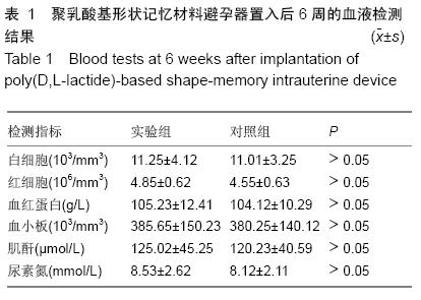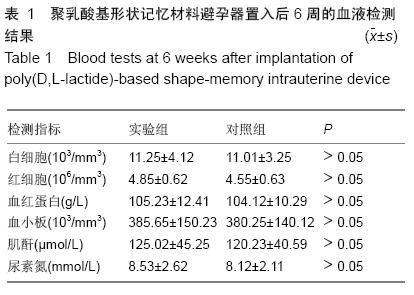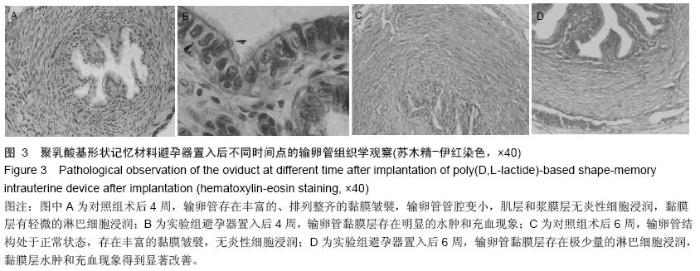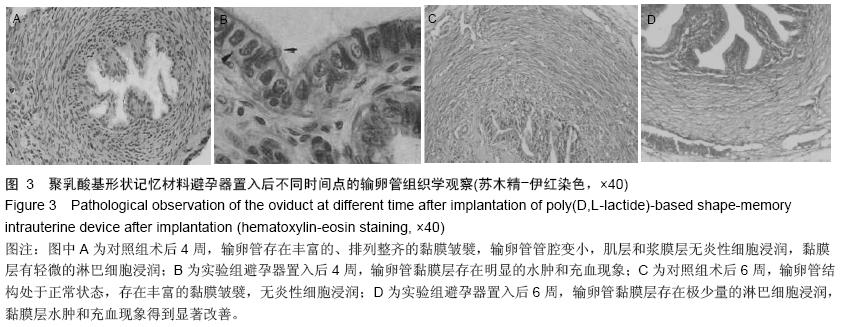| [1] 卢瑶,夏春玲.形状记忆输卵管避孕材料与其他输卵管避孕材料的特点分析[J].中国组织工程研究, 2013,17(47): 8263-8268.[2] 李永刚.具有形状记忆功能的D, L-聚乳酸基输卵管避孕材料的制备与研究[D].重庆大学,2009.[3] 张觇宇.形状记忆输卵管避孕器材料的研制及应用基础研究[D].第三军医大学,2008.[4] 范玉荣,王凤英,唐帅,等.聚乳酸基形状记忆材料对兔输卵管黏膜的影响[J].生殖与避孕,2009,29(1):12-16.[5] 须建,彭坤,甘哓玲,等.D, L-聚乳酸基形状记忆聚合物的生物安全性和细胞相容性[J].中国组织工程研究, 2013, 17(38):6753-6758.[6] 刘钊.具有形状记忆功能的D, L-聚乳酸基输卵管避孕材料的研究[D].重庆大学,2010.[7] 唐帅.具有形状记忆特性的输卵管绝育器的制备及实验研究[D].第三军医大学,2010.[8] 唐帅,范玉荣,张觇宇等.聚乳酸基形状记忆输卵管节育器对兔输卵管的堵塞效果研究[J].生殖与避孕, 2010,30(4): 235-239. [9] Steendam R, Hennink WE, Frijlink HW, et al. Effect of molecular weight and glass transition on relaxation and release behaviour of poly(DL-lactic acid) tablets. J Controll Release. 2001;70(1/2):71-82.[10] 徐萍萍,杨利华,魏桂芝,等.男性避孕纳米粒的制备与体外实验研究[J].第三军医大学学报, 2015,37(4):351-355.[11] 王芳,毛熙光,郭庆云,等.非生物降解和生物可降解长效缓释避孕系统的应用[J].中国组织工程研究与临床康复, 2009,13(8):1561-1564.[12] 范玉荣.形状记忆输卵管绝育器的设计及体内生物相容性的实验研究[D].第三军医大学,2009.[13] Steendeam R, Lerk CF. The role of elastic relaxation in drug delivery from poly(dllactic acid) based tablets. A shape memory phenomenon//The 25th International Symposium on Controlled Release of Bioactive Materials and the First Consumer and Diversified Products Conference,1998:128-129.[14] 张觇宇,罗彦凤,王远亮,等.形状记忆输卵管避孕材料的急性毒性研究[J].重庆医学,2008,37(17):1943-1944.[15] 彭坤,罗彦风,甘晓玲,等.女性用避孕节育器进展[J].重庆医学,2009,38(13):1658-1659.[16] 付正英,郭延玲.可复性镍钛形状记忆合金输卵管微型节育器的研制[J].医疗卫生装备,2012,33(4):31-32.[17] 郭香云,田慧,殷玲玲,等.MCu功能性宫内节育器避孕效果观察[J].基层医学论坛,2006,10(2):40.[18] 史凤阳.新型形状记忆合金IUD的临床应用[C].//第二届中国计划生育/生殖健康新产品、新技术博览会暨2003中国计划生育/生殖健康产业论坛论文集,2003:87-89.[19] 张觇宇,罗彦凤.形状记忆输卵管避孕材料的急性毒性研究[J].重庆医学,2008,37(17):1934-1944.[20] 朱光明,刘忠让.形状记忆聚合物及其在生物医学工程中的应用[J].生物医学工程学杂志,2005,22(5):1082-1084.[21] 马艳,石文鹏,赵辰阳,等.聚乳酸基可降解形状记忆聚合物的制备、结构与性能[J].化学学报,2011,69(6):719-724.[22] Petchsuk A, Klinsukhon W, Sirikittikul D, et al. Parameters affecting transition temperatures of poly(lactic acid-co-polydiols) copolymer-based polyester urethanes and their shape memory behavior. Polym Adv Technol. 2012;23(8):1166-1173.[23] Radjabian M, Kish MH, Mohammadi N, et al. Structure- property relationship for poly(lactic acid) (PLA) filaments: Physical, thermomechanical and shape memory characterization. J Polym Res.2012; 19(6):9870.[24] Han DK, Park K, Park KD, et al. In vivo biocompatibility of sulfonated PEO-grafted polyurethanes for polymer heart valve and vascular graft. Artif Organs. 2006;30(12):955-959.[25] Kannan RY, Salacinski HJ, Odlyha M, et al. The degradatie resistance of polyhedral oligomeric silsesquioxane nanocore integrated polyurethanes: An in vitro study. Biomaterials. 2006;27:1971-1979.[26] Grad S, Kupcsik L, Goma K, et al. The use of biodegradable polyurethane scaffolds for cartilage tissue engineering potential and limitations. Biomaterials. 2003;24(28):5136-5171.[27] 李小平,潘德,王玮,等.医用聚氨甲酸乙酯栓堵对兔输卵管影响的初步观察[J].现代妇产科进展,1996,5(2):179-181.[28] 武元鹏,丁强,李晶,等.基于聚乳酸的可降解形状记忆高分子的研究进展[J].高分子通报,2012,25(10):33-39.[29] 马殉,朱光明.生物降解性形状记忆聚合物的研究进展[C]. //2009年中国工程塑料复合材料技术研讨会论文集, 2009:295-298.[30] Shikinami Y, Okuno M. Mechanical evaluation of novel spinal interbody fusion cages made of bioactive, resorbablecomposites. Biomaterials. 2003;24(18): 3161-3170.[31] 郑晓彤,周绍兵,冯波,等.聚乳酸/羟基磷灰石的形状记忆性能[C].//2006年全国博士生学术论坛-材料科学分论坛论文集,2006:388-390.[32] 鲁玺丽.可生物降解形状记忆聚L-乳酸及其共聚物的结构与性能[D].哈尔滨工业大学,2006.[33] Inoue K, Yamashiro M, Iji M, et al. Recyclable Shape-Memory Polymer: Poly(lactic acid) Crosslinked By a Thermoreversible Diels–Alder Reaction. J Appl Polym Sci. 2009;112(2):876-885.[34] Yamashiro M, Inoue K, Iji M, et al. Recyclable Shape-memory and Mechanical Strength of Poly(lactic acid) Compounds Cross-linked by Thermo-reversible Diels-Alder Reaction. Polym J. 2008;40(7):657-662.[35] Raja M, Ryu SH, Shanmugharaj AM, et al. Thermal, mechanical and electroactive shape memory properties of polyurethane (PU)/poly (lactic acid) (PLA)/CNT nanocomposites. Eur Polym J. 2013;49(11): 3492-3500.[36] Ruan C, Wang Y, Zhang M, et al. Design, synthesis and characterization of novel biodegradable shape memory polymers based on poly(D, L-lactic acid) diol, hexamethylene diisocyanate and piperazine. Polym Int. 2012;61(4):524-530.[37] 马艳,禄琪,范仲勇,等.聚乳酸基可降解形状记忆聚合物的制备、结构与性能[C].//中国化学会第28届学术年会论文集,2012.[38] 金和,林煜祥,徐立,等.PCL/PLLA共混物的制备及其形状记忆功能研究[J].工程塑料应用,2013,41(4):9-12.[39] 郑兵.Fe3O4/聚乳酸基聚氨酯纳米复合形状记忆材料的制备及性能研究[D].华东师范大学,2010.[40] 逮琪.可降解形状记忆材料的制备、结构及性能[D].复旦大学,2009. |





